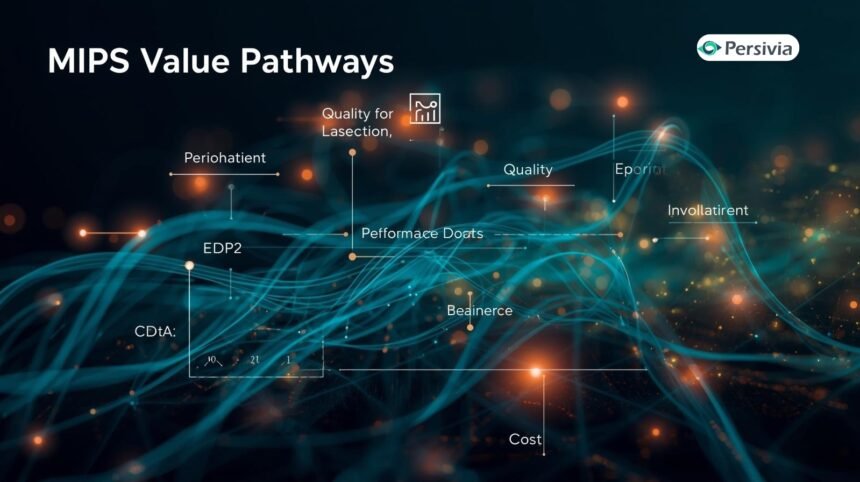MIPS Value Pathways streamline performance reporting to include specialty measure sets, which streamline administration and tie quality, cost, and improvement efforts together. As an intermediary between fee-for-service and advanced APMs, MVPs are more affordable for value-based care. Having optional participation until 2025, providers will be able to implement these pathways gradually to improve Medicare reimbursement results.
The medicare payment is changing rapidly. Clinical excellence requires providers to become increasingly cost-effective and, at the same time, meet mounting pressure to demonstrate clinical excellence. Days of recording services are past, and the current healthcare environment requires evidence of value in the form of measurable outcomes and strategic reporting.
The MIPS Value Pathways were introduced to solve a long-standing issue: traditional MIPS reporting was too complex and not specialty-aligned. Clinicians wasted hours navigating measures that are not based on their populations of patients or their clinical specialization. MVPs transform this and instead bring together related measurements by medical specialties and clinical conditions to form a reporting structure, which, in fact, would make sense regarding the practice of medicine by the providers.
What are MIPS Value Pathways?
MIPS Value Pathways are reporting systems in the Merit-based Incentive Payment System that are specialty-centered. They cluster quality measures, cost measures, and improvement activities into consistent bundles that are specific to a particular medical specialty or clinical conditions.
Note: Think of MVPs as MIPS 2.0. Providers then pick pathways made out of their real practice, rather than picking out hundreds of disconnected measures. A cardiologist provides the metrics on cardiovascular care. A rheumatologist specializes in the treatment of chronic diseases. Each pathway narrates a story of patient care in its entirety as opposed to gathering single pieces of data.
Key Components of MVPs
MVPs integrate three essential elements:
- Quality Measures: Outcome-focused metrics specific to each specialty
- Cost Metrics: Population-based cost calculations using claims data
- Improvement Activities: Targeted initiatives that enhance care delivery
This integration creates a comprehensive performance picture. Providers not only view the results they get, but also the efficiency with which they provide care and the steps to make things improve constantly.
How Do MVPs Simplify MIPS Reporting?
MVPs dramatically reduce reporting complexity by offering curated measure lists. Clinicians no longer wade through extensive catalogs of irrelevant options. CMS provides specialty-specific measures that directly relate to each provider’s clinical practice.
The simplification extends to data submission. MVPs leverage administrative claims data for cost and population health measures, which means less manual entry and fewer chances for errors. Clinicians can focus more on care delivery and less on reporting logistics.
Reporting Flexibility Across Entity Types
MIPS reporting accommodates different organizational structures:
- Individual providers
- Group practices
- Virtual groups
- APM entities
- Subgroups (the mechanism enabling MVP participation)
Multispecialty groups benefit significantly. Previously forced into one-size-fits-all reporting, these organizations now use subgroup structures to report specialty-specific data that reflects their diverse practices.
Automation Benefits
Automated claims data collection transforms the reporting burden. The system pulls cost metrics and population health data directly from administrative records, cutting manual submission needs by significant margins. This automation saves time and reduces human error in data collection.
Why Quality Measurement Matters in MVPs
MIPS Value Pathways is founded on quality. These frameworks focus on outcome measures and high-priority indicators specific to every medical specialty or clinical condition.
The focus ensures measured metrics actually matter. Providers track aspects of care that impact patient health most directly. A diabetes-focused MVP measures glycemic control and complication rates. An orthopedic pathway tracks surgical outcomes and functional recovery.
Integration Creates Comprehensive Performance Pictures
Quality measures don’t exist in isolation within MVPs. They link with cost considerations and improvement activities to show:
- What outcomes providers achieve
- How efficiently they achieve them
- What steps drive ongoing improvement
This related perspective is useful in enabling the providers to see their performance in a holistic manner and not in a fragmented way.
Outcome-Focused Approach
MVPs prioritize outcomes over process measures. Instead of documenting that something was done, providers demonstrate that patients actually improved. This shift aligns reporting with what matters most: patient health and wellbeing.
MVPs as a Bridge to Advanced Payment Models
MIPS Value Pathways serve a strategic role beyond simplified reporting. They establish a logical evolution of traditional fee-for-service to Alternative Payment Models (APM).
The alignment between MVPs and APMs makes transitions smoother. Providers already reporting through MVPs develop the data infrastructure, quality measurement capabilities, and performance tracking needed for advanced models. When ready to take on greater financial risk for greater flexibility, the groundwork already exists.
Building Toward Value-Based Care
MVPs teach providers to think differently about care delivery:
- Focus on outcomes rather than volume
- Connect quality with cost efficiency
- Implement systematic improvement processes
- Track performance across patient populations
These capabilities form the foundation for success in value-based arrangements. Providers develop the mindset and operational systems needed before taking on downside risk.
Who Can Participate in MVPs?
Any eligible MIPS participant can choose MVP reporting. The framework promotes many practice structures and specialties, and CMS is constantly increasing the number of pathways.
Existing participation is on an optional basis up to 2025. This is a risk-free opportunity to get experience in specialty-oriented reporting without getting subjected to learning curve penalties.
Subgroup Reporting Structure
Subgroups are the specific mechanism enabling MVP participation. Groups must register subgroups through the CMS Quality Payment Program portal. Each subgroup should include clinicians from the same specialty or who treat the same condition.
Requirements for subgroup formation:
- Minimum of two clinicians per subgroup
- All subgroup members must share the same TIN
- Clinicians report as a subgroup, not individually
- One MVP selection per subgroup for the performance year
Available MIPS Value Pathways
CMS offers multiple MVPs covering various specialties and conditions. The list continues expanding as the agency recognizes that different clinical focuses require tailored measurement approaches.
| Category | Example Pathways |
| Chronic Conditions | Diabetes, Heart Disease, COPD |
| Surgical Specialties | Orthopedics, General Surgery |
| Primary Care | Family Medicine, Internal Medicine |
| Specialty Care | Cardiology, Nephrology, Rheumatology |
The pathways have 4-6 measures of quality, pertinent improvement activities, and measures of costs arising in that clinical focus. Providers choose the route that is most appropriate to their population of patients and the type of practice.
Expansion Plans
CMS signals continued growth in MVP options. The agency recognizes that diverse medical specialties and clinical conditions need customized performance measurement. More pathways mean better alignment between reporting requirements and actual clinical practice.
What are the Benefits of Adopting MVPs?
MIPS Value Pathways deliver tangible advantages beyond simplified reporting. Providers gain strategic benefits that impact both practice operations and patient care.
Reduced Administrative Burden
Time savings matter. When clinicians spend less time on reporting tasks, they invest more in care delivery improvements. The streamlined MVP process cuts administrative hours significantly, according to early adopter feedback.
Improved Clinician Engagement
Relevant measures drive engagement. Providers connect with quality reporting when metrics reflect their actual practice. A pathway designed for their specialty makes performance measurement meaningful rather than bureaucratic.
Better Patient Outcomes
Measures that are focused result in targeted improvements. Quality improvement programs are more effective when providers focus on the measures that are directly related to their clinical specialty. With care delivery improvements, patients are offered the most significant health aspects and the most influential ones.
Enhanced Performance Scores
Specialty-relevant measures often lead to better performance scores. It means that providers perform better when assessed based on what they are doing as opposed to standardized measures that do not necessarily apply to their patients.
Strategic Positioning
Early MVP adoption is a practice that postulates the emerging healthcare environment. The organizations can get practice on value-based reporting structures as they can engage voluntarily with minimal risk and develop capabilities.
How to Prepare for MVP Participation
MVP adoption needs to be strategically planned in order to be successful. Implementation should be done in a systematic way by the providers and not at the last moment.
Steps for Getting Started
- Assess your specialty focus: Identify which MVP best aligns with your patient population and clinical practice. Review available pathways and their specific measure requirements.
- Evaluate your data infrastructure: Determine whether your current systems can capture and report MVP measures. A robust digital health platform becomes essential for tracking quality metrics, managing improvement activities, and automating data submission.
- Register subgroups appropriately: Structure your organization to enable MVP reporting. Multispecialty groups should create subgroups that reflect different clinical focuses within the practice.
- Train your team: Everyone involved in care delivery and documentation should understand MVP requirements. Clear communication ensures consistent data capture and reporting.
- Monitor performance regularly: Measures metrics on an annual basis and does not rush to meet the reporting deadlines. Monitoring in real-time allows identifying areas of improvement as soon as possible, when intervention can have the most significant influence.
Technology Considerations
The right technology makes MVP participation manageable. Look for platforms that offer:
- Automated data collection from clinical workflows
- Real-time performance dashboards
- Measure-specific tracking for chosen pathways
- Integration with existing EHR systems
- Submission capabilities for all MIPS categories
Technology is not supposed to be a complication. The objective is smooth integration, which contributes to and does not interfere with clinical operations.
Common Challenges and Solutions
Every new reporting framework presents challenges. Understanding potential obstacles helps providers prepare effective solutions.
Data Quality Issues
Incomplete or inaccurate data undermines MVP performance. Combat this through systematic documentation, training, and regular data audits. Automated validation tools catch errors before submission.
Measure Selection Confusion
Choosing the right MVP requires understanding your patient population. Analyze your current patient mix and clinical services. Select pathways where you already deliver high-quality care rather than trying to fit into misaligned categories.
Subgroup Formation Complications
Large multispecialty groups may struggle with optimal subgroup structure. Start with clear specialty divisions. Ensure each subgroup has sufficient patient volume to report required measures accurately.
Resource Constraints
Small practices worry about the resources needed for MVP adoption. Focus on pathways with measures already captured in existing workflows. Leverage technology that automates data collection rather than creating additional manual tasks.
Why Optional Participation Until 2025 Matters
CMS deliberately made MVP participation optional through 2025. Such a grace period is strategic because it enables the providers to test the waters without reprisals.
The smart organizations see this window to be an opportunity and not a reason to wait. There are several benefits that early adopters have:
- Practice in specialty-oriented reporting prior to making it obligatory.
- Time to refine data collection processes
- Opportunity to identify best practices
- Positioning for success as value-based care models expand
The optional period won’t last forever. Providers who wait until requirements change face steeper learning curves under pressure.
Conclusion
MIPS Value Pathways represent a fundamental shift in Medicare performance reporting. By focusing on specialty-specific measures, reducing administrative burden, and connecting quality with cost efficiency, MVPs make value-based care more practical and meaningful. The framework bridges traditional reporting with advanced payment models, creating a clear progression path for providers ready to evolve their practice models. Having optional participation through the year 2025, it is time to go and put your organization in a position to achieve success in the long run in a healthcare environment that is becoming more and more value-based.
Why Persivia?
Succeeding with MIPS Value Pathways takes more than compliance. It requires technology that simplifies reporting and strengthens performance. Persivia’s clinical quality management platform does exactly that, powered by advanced algorithms, real-time monitoring, and data normalization.
The platform supports programs such as Promoting Interoperability, HEDIS, Primary Care First, ACO REACH, and MSSP ACO, covering all MIPS Value Pathways and quality measures. With rapid setup and end-to-end support, Persivia helps providers optimize MVP performance and achieve sustainable success in value-based care.









